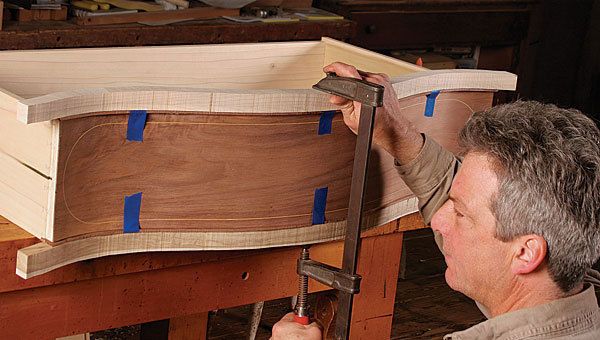How to Tackle a Serpentine Drawer
From drawer fronts to table aprons, this veneered shape has many uses
Synopsis: The simple, pleasing shape of a serpentine drawer front is not all that simple to design and construct. Jeff Headley first builds a core from layers of a secondary wood such as poplar, veneers the curved surface, fits the drawer front to the carcase opening, and applies cock beading around the drawer. Here, he offers two methods for building the core and takes you step by step through the process of fitting the curved core to the case. He offers tips for cutting dovetails in the curved surface, as well as fitting the veneer and applying the beading. An accompanying Master Class article, he details how to add an oval inlay to the veneered drawer front.
The serpentine shape is a simple yet pleasing form, which explains why it is found on so many types of furniture. However, its design and construction are not so simple. Although there are some antiques that were made by cutting serpentine shapes from solid wood, this represents a huge waste of high-priced lumber and the result is relatively heavy and coarse looking.
The method I used on the drawers in this chest is more straightforward. Build the core from 1-in.-thick layers of poplar, veneer the curved surface, fit the drawer front to the opening in the chest, and apply cock beading around the drawer. you can use this technique on any serpentine piece, from drawers to table aprons.
Build the core from secondary wood
Before you start on the drawers you should build the rest of the carcase, as the drawers are built to fit the opening and not the other way around. The other serpentine-shaped parts, the top and the drawer dividers, are easily cut on the bandsaw.
There are two ways to make the serpentine core, but for both, use the pattern from the chest rails to lay out the 1-in.-thick cores, leaving them 2 in. long. I make the core by gluing layers of boards until they equal the height of the tallest drawer front. They should be wide enough to accommodate the number of drawer fronts, plus the depth of the serpentine, plus enough scrap to be used as a caul for veneering. This large blank is heavy and awkward, so be careful when cutting it on the bandsaw. Try to cut cleanly; time spent here will pay dividends in less cleanup time.
Use spokeshaves to clean up the surface. A flat-bottomed spoke shave works on most areas, with a curved one getting into the bottom of curves. Remove the sawmarks evenly across the width of the core to keep the thickness even. With today’s thin veneers, you must be very thorough in cleaning up the core because any ripple will transfer through the veneer.
From Fine Woodworking #199
For the full article, download the PDF below:
Fine Woodworking Recommended Products

Starrett 12-in. combination square

Bessey K-Body Parallel-Jaw Clamp

Stanley Powerlock 16-ft. tape measure























Log in or create an account to post a comment.
Sign up Log in